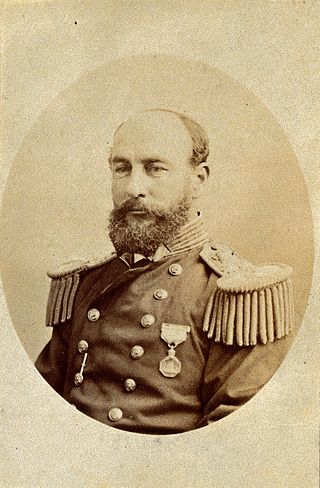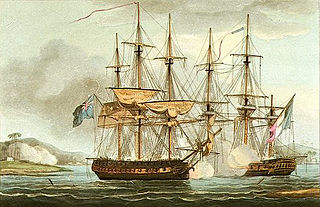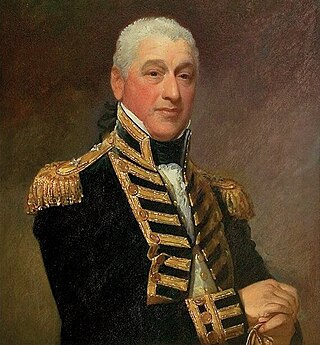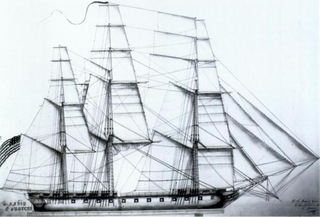
Vice-Admiral Sir George Strong Nares was a Royal Navy officer and Arctic explorer. He commanded the Challenger Expedition, and the British Arctic Expedition. He was highly thought of as a leader and scientific explorer. In later life he worked for the Board of Trade and as Acting Conservator of the River Mersey.

HMS Resolute was a mid-19th-century barque-rigged ship of the British Royal Navy, specially outfitted for Arctic exploration. Resolute became trapped in the ice searching for Franklin's lost expedition and was abandoned in 1854. Recovered by an American whaler, she was returned to Queen Victoria in 1856. Timbers from the ship were later used to construct the Resolute desk which was presented to the President of the United States and is located in the White House Oval Office.

Vice-Admiral Sir Robert John Le Mesurier McClure was an Irish explorer who explored the Arctic. In 1854 he traversed the Northwest Passage by boat and sledge, and was the first to circumnavigate the Americas.

Sir Horatio Thomas Austin was a British Royal Navy officer and explorer.

Robert Maynard was a British Royal Navy officer. Little is known about Maynard's early life, other than that he was born in England in 1684 and then later joined the English Navy. He was made a lieutenant in January 1707, and by 1709 was the third lieutenant on HMS Bedford.

Francis Rawdon Moira Crozier was an Irish officer of the Royal Navy and polar explorer who participated in six expeditions to the Arctic and Antarctic. In 1843, he became a Fellow of the Royal Society for his scientific work during his expeditions. Later, he was second-in-command to Sir John Franklin and captain of HMS Terror during the Franklin expedition to discover the Northwest Passage, which ended with the loss of all 129 crewmen in mysterious circumstances.

Arthur Fleming Morrell was British officer of the Royal Navy, an explorer, and Commandant of Ascension Island, who saw service spanning the end of the Napoleonic era and well into the Victorian era.

Admiral Sir Ragnar Musgrave Colvin, was a long-serving Royal Navy officer who commanded the Royal Australian Navy (RAN) at the outbreak of the Second World War.

Admiral Sir Albert Hastings Markham was a British explorer, author, and officer in the Royal Navy. In 1903 he was invested as a Knight Commander of the Order of the Bath. He is also remembered for designing the flag of New Zealand.

Sir Henry Frederick Stephenson was a Royal Navy officer, courtier, and Arctic explorer.

The Persian Gulf campaign of 1809 was an operation by the British East India Company backed by the Royal Navy to force the Al Qasimi to cease their raids on British ships in the Persian Gulf, particularly on the Persian and Arab coasts of the Strait of Hormuz. The operation's success was limited as the Royal Navy forces, already heavily involved in the Napoleonic Wars, were unable to permanently suppress the strong fleets of the Al Qasimi of Ras Al Khaimah and Sharjah. The expedition did achieve its short-term goals by destroying three Al Qasimi bases and over 80 vessels, including the largest Al Qasimi ship in the region, the converted merchant ship Minerva. Although operations continued into 1810, the British were unable to destroy every Al Qasimi vessel. By 1811, attacks had resumed, although at a lower intensity than previously.

Chiffonne was a 38-gun Heureuse-class frigate of the French Navy. She was built at Nantes and launched in 1799. The British Royal Navy captured her in 1801. In 1809 she participated in a campaign against pirates in the Persian Gulf. She was sold for breaking up in 1814.
Rear Admiral Sir Francis Augustus Collier, CB, KCH was a senior officer of the British Royal Navy during the early nineteenth century. Born into a naval family, Collier served in the French Revolutionary Wars and fought at the Battle of the Nile on Horatio Nelson's flagship. During the Napoleonic Wars he was engaged in campaigns in the West Indies and in 1819 he commanded an operation against pirates in the Persian Gulf. He remained in service for the next thirty years, holding several commands before his death in 1849 as commander of the China Squadron at Hong Kong.

Admiral Sir Isaac Coffin, 1st Baronet was an officer of the Royal Navy who served during the American War of Independence and the French Revolutionary and Napoleonic Wars.

The Battle of Tonkin River was a major naval battle fought in northern Vietnam between the pirates of Shap Ng-tsai and the British Royal Navy with aid from the Qing Chinese navy and the Tonkinese. The 1849 expedition led to the destruction of Shap Ng-tsai's fleet and the loss of over 2,000 men. The battle occurred over a three-day period at the mouth of the Tonkin River, near present-day Hai Phong.

The West Indies Squadron, or the West Indies Station, was a United States Navy squadron that operated in the West Indies in the early nineteenth century. It was formed due to the need to suppress piracy in the Caribbean Sea, the Antilles and the Gulf of Mexico region of the Atlantic Ocean. This unit later engaged in the Second Seminole War until being combined with the Home Squadron in 1842. From 1822 to 1826 the squadron was based out of Saint Thomas Island until the Pensacola Naval Yard was constructed.

The West Indies Anti-Piracy Operations were a series of military operations and engagements undertaken by the United States Navy against pirates in and around the Antilles. Between 1814 and 1825, the American West Indies Squadron hunted pirates on both sea and land, primarily around Cuba and Puerto Rico. After the capture of Roberto Cofresi in 1825, acts of piracy became rare, and the operation was considered a success, although limited occurrences went on until slightly after the start of the 20th century.

James Fitzjames was a British Royal Navy officer and explorer.

Admiral Francis Erskine Loch was a senior commander in the Royal Navy during the early 19th century. He served as naval aide-de-camp to Queen Victoria.
HCS Vestal was built in 1809 at the Bombay Dockyard for the Bombay Marine, the naval arm of the British East India Company (EIC). She spent much of her career suppressing commerce raiding in the Persian Gulf. Lastly, she figured in a notable action during the First Anglo-Burmese War. She was subsequently condemned as unserviceable and sold for breaking up.

















